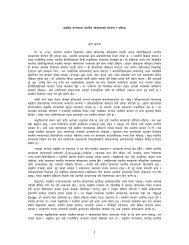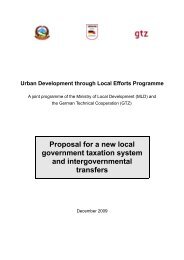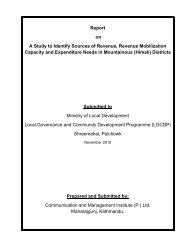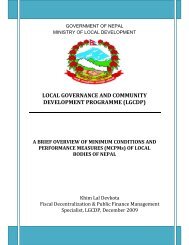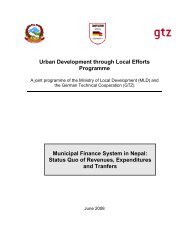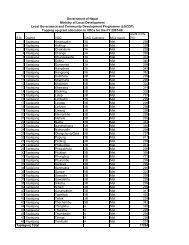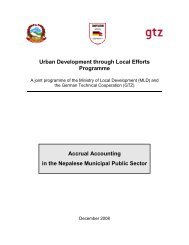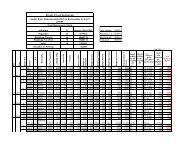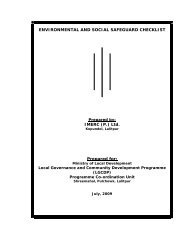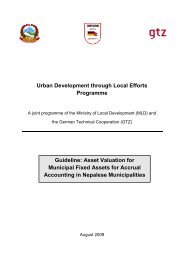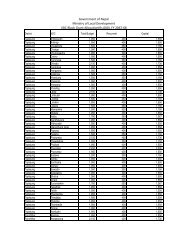LGCDP M&E Framework
LGCDP M&E Framework
LGCDP M&E Framework
You also want an ePaper? Increase the reach of your titles
YUMPU automatically turns print PDFs into web optimized ePapers that Google loves.
Representation<br />
Indicator: Number of poor households (based on 8 indicators used in MLD DAG mapping) where<br />
no member was previously engaged in any organization in the last 3 years, but<br />
now is engaged in either school management committee, health management<br />
committee or VDC<br />
Rationale: • This indicator looks at the number of people who have been left out of the decisionmaking<br />
process at local level in the past but could be encouraged be become engaged<br />
in some way.<br />
Limits: • This indicator tracks membership in three key organizations at the local level: the<br />
school management committee, the health management committee and the Village<br />
Development Committee) as a proxy for all organizations closely related to<br />
participation in decision-making at the local level.<br />
• Data for this indicator is difficult to collect and based on a previous DAG mapping<br />
exercise. However, this data is at the core <strong>LGCDP</strong>, therefore collecting data for it is<br />
paramount.<br />
Baseline:<br />
To be determined after first data collection by social mobilizers<br />
Target:<br />
To be determined after<br />
Means of<br />
Verification<br />
This data will need to be collected through administrative data from <strong>LGCDP</strong>’s social<br />
mobilizers. The details for this data collection exercise still need to be established.<br />
Frequency annually<br />
Responsibility M&E Section of MLD through social mobilizsers<br />
Indicators: • % of women in all Integrated Planning Committees at VDC level<br />
• % of members of disadvantaged groups in all Integrated Planning<br />
Committees at VDC level<br />
Rationale: • This indicator reflects the level of representation by women and disadvantaged groups<br />
in the planning process at VDC, DDC and municipality level.<br />
Limits: • Currently, Integrated Planning Committees do not exist. The percentage figure<br />
depends on the number of Integrated Planning Committees formed.<br />
• The first of these indicators tracks only the VDC level as a proxy for the DDC and the<br />
municipality level. The underlying assumption is that clear changes at the VDC level<br />
will most likely be reflected at the DDC and municipality level.<br />
Baseline: To be determined by <strong>LGCDP</strong> baseline survey in 2009<br />
Target:<br />
To be determined after the <strong>LGCDP</strong> baseline survey<br />
Means of<br />
Verification<br />
Frequency<br />
Responsibility<br />
Inclusion<br />
Data should be collected through two sources:<br />
• sample surveys conducted by MLD<br />
• collection of administrative data from VDCs, DDCs to MLD<br />
sample surveys can continue to collect this data for triangulation and quality control of<br />
administrative data<br />
every 2 years (2009, 2011, 2013 for sample survey) / annually (administrative data)<br />
M&E Section of MLD (for both survey and administrative data)<br />
Indicators: • % of total budget of DDCs which explicitly targets women<br />
• % total budget of DDCs which explicitly targets members of disadvantaged<br />
groups<br />
Rationale: • These indicators go beyond block grants and track ‘inclusiveness’ by looking at the<br />
overall share of the DDC budget which is spent on women and members of<br />
disadvantaged groups<br />
Limits: • The difficulty will be to determine objectively if funds are explicitly target women<br />
and/or disadvantaged groups or if they only implicitly effect them (but many others as<br />
well). The definitions will need be clearly laid out in the Gender and DAG Budget Audit<br />
guidelines.<br />
Baseline: To be determined by <strong>LGCDP</strong> baseline survey in 2009<br />
Target:<br />
To be determined after the <strong>LGCDP</strong> baseline survey<br />
Means of<br />
Verification<br />
Frequency<br />
Responsibility<br />
Data should be collected through three sources:<br />
• <strong>LGCDP</strong> Sample Surveys,<br />
• Gender Budget Audits<br />
• Sample DAG Budget Audits<br />
every 2 years (2009, 2011, 2013 for sample survey) / annually (administrative data)<br />
M&E Section of MLD / GESI Section of MLD<br />
10



